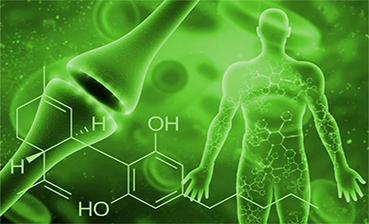
The endocannabinoid system | Fifth Ave Green House
What is the endocannabinoid system?
The endocannabinoid system (ECS) was discovered in the 1960s and 70s after studying the effects of cannabis on the body. The ECS is a complex system that acts as a communication hub between the brain and essential body parts and functions. Despite extensive research, it is still not fully understood. However, scientists have found that it plays an important role in our sleep, mood, appetite, memory, and reproductive functions. The ECS is always active in your body, regardless of whether you are ingesting cannabis or not.
How does the endocannabinoid system work?
There are three central components of the ECS: endocannabinoids (eCBs), cannabinoid receptors (CB receptors), and enzymes that synthesize and break down the eCBs.
Endocannabinoids (eCBs)
Just as the body’s nervous system uses neurotransmitters such as dopamine and serotonin as chemical messengers, the ECS uses endocannabinoids (eCBs) as messengers that are produced throughout the body.
The two critical endocannabinoids identified so far are anandamide (AEA) and
2-arachidonoyl glycerol (2-AG).
Anandamide (AEA)
Anandamide, also known as N-arachidonoylethanolamine, was discovered in the 1990s and is a fatty acid neurotransmitter. Anandamid was named after the Sanskrit word ananda, which means “bliss / joy”. It is common throughout the ECS and deals with memory, appetite, and pregnancy, to name a few of its functions. The “runners high” experienced during intense workouts have been associated with it.
2-arachidonoyl glycerine (2-AG)
Recent research has linked 2-AD to emotional states, as well as maintaining cardiovascular health and preventing seizures. It was found in beef and breast milk. It is also related to the satisfying feeling you experience after orgasm. In contrast to anandamide, 2-AG occurs in relatively high concentrations in the central nervous system.
Cannabinoid receptors (CB receptors)
These receptors are found all over your body. They sit on the surface of cells and wait to be triggered by the eCBs when these neurotransmitters bind to them.
There are two main CB receptors. CB1 receptors and CB2 receptors. Most cannabinoids can bind to both CB1 and CB2 receptors. This is the case with both endocannabinoids, 2-AG and AEA. However, this is not the case with CBD, which does not trigger the receptor directly. Rather, change the receptor’s ability to bind to cannabinoids. The results depend on which cell type the CB receptors are on and which eCBs bind to them.
CB1 receptors are the most common receptors in the central nervous system. They are important for healthy brain function. Depending on the area of the brain they are in, they can moderate mood (amygdala), memory (caudate nucleus / hippocampus), motor function (cerebellum), and your perception of pain. As you may have guessed, they are also responsible for the psychoactive properties of cannabis when they bind to THC. While they are most commonly found in the central nervous system, CB1 receptors are also found in other parts of the body, but in lower concentrations. They play a role in hormone production, pregnancy, digestion, and cardiovascular health.
Photo credit: Headsup.scholastic.com
CB2 receptors are most common in your body’s peripheral nervous system, especially the immune system. They help with inflammation and immune responses against pathogens. If you use cannabis to treat asthma, allergies, arthritis, or autoimmune diseases, your CB2 receptors should be thankful.
Photo credit: cbdpillow.com
Enzymes
If endocannabinoids (eCBs) are the messenger substances, the enzymes are the system that generates the messages. You can think of them as the management system of the ECS telling the messengers where to go, when they are needed, and in what quantities. eCBs are lipid-based neurotransmitters and are therefore synthesized from fats. The body uses enzymes that work together and turn the fat into A2G and AEA. So eating a healthy diet with adequate intake of good fatty acids like omega-3 and omega-6 will help your body have the resources to produce eCBs.
After the 2-AG and AEA eCBs get their message across and do their job, the body needs to find a way to turn them off. Otherwise, they will stimulate the ECS forever. Transport proteins transport the eCBs to storage locations in the body, where enzymes can then break them down and recycle them.
Two of the best studied enzymes used to break down and break down the eCBs are MAGL and FAAH. MAGL collapses 2-AG and FAAH does the same for AEA.
An interesting genetic variation in around 20% of adults means that their FAAH enzymes are compromised. The result is increased AEA levels, which makes these people less anxious. CBD also inhibits these enzymes so that it can support the body’s own feel-good factor AEA and 2-AG.
Promote good ECS health
Each eCB can bind to many receptors, and each receptor can bind to many eCBs, creating a jumble of links and messages flying around the body. Many other molecules disrupt or facilitate this bond, and because of this intricate detail, scientists are still trying to weave this web and fully understand it. There are thousands of articles and studies that have helped us better understand the ECS. We have learned that the ECS can be easily unbalanced by the hectic pace of our modern life. Stress, exercise and diet play a role. When trying to balance your ECS there are over 100 different phytocannabinoids like THC, THCa, CBD, CBDa, CBN, etc., all of which can have slightly different effects on the CB receptors in your body. As our understanding of the ECS expands, we will develop ways to reach certain aspects of your immune and nervous systems without activating the entire system.
You may also want to learn all about CBD concentrates or read our article on the website History of the bong.

Post a comment: